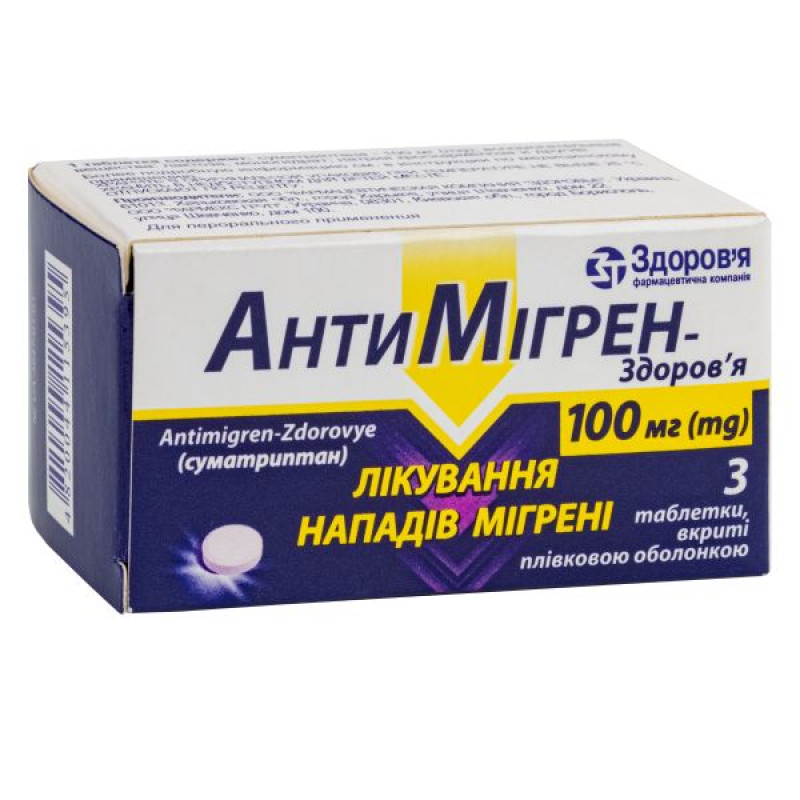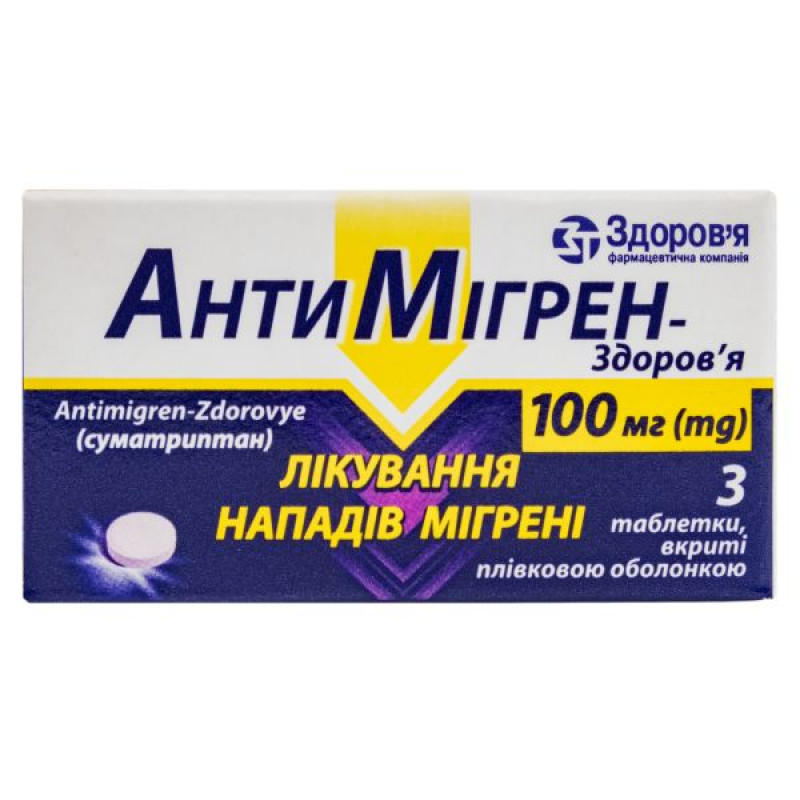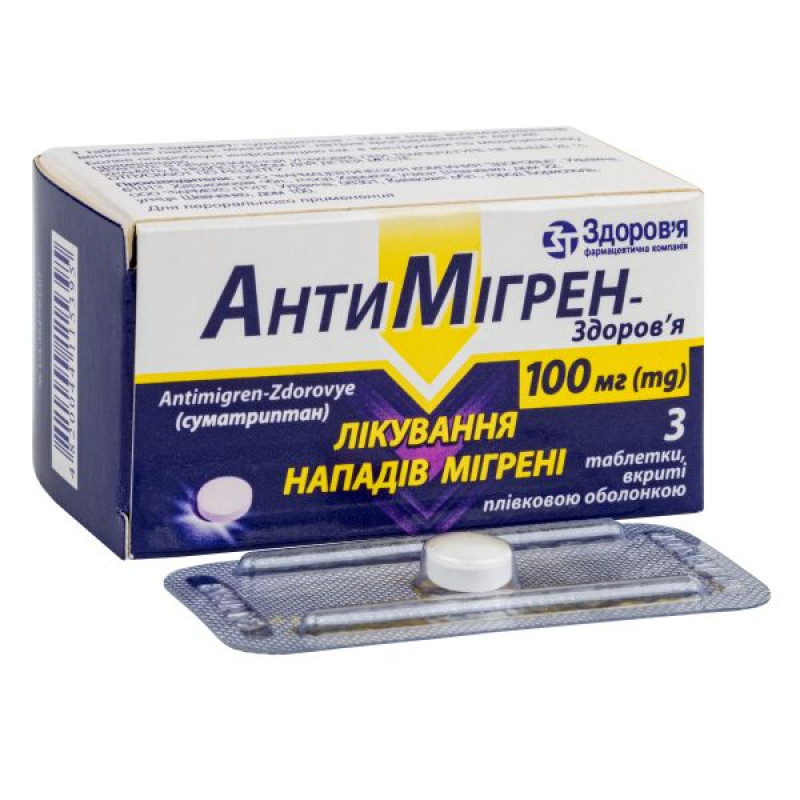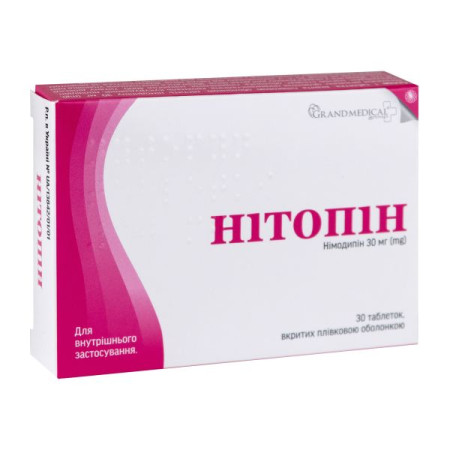Antimigraine-Health film-coated tablets 100 mg blister No. 3

Instructions Antimigraine-Health film-coated tablets 100 mg blister No. 3
Composition
active ingredient: 1 tablet contains sumatriptan 50 mg or 100 mg;
Excipients: lactose monohydrate; povidone; microcrystalline cellulose; calcium stearate; croscarmellose sodium; colloidal anhydrous silica; titanium dioxide (E 171); hypromellose.
Dosage form
Film-coated tablets.
Main physicochemical properties: film-coated tablets, white with a yellowish tint.
Pharmacotherapeutic group
Drugs used in the treatment of migraine. Selective serotonin 5HT1 receptor agonists. Sumatriptan. ATC code N02C C01.
Pharmacological properties
Pharmacodynamics
Sumatriptan is a selective agonist of 5HT1 receptors that does not affect other 5HT receptors. These receptors are mainly found in the craniocerebral blood vessels. Experimental studies have shown that sumatriptan has a selective vasoconstrictor effect on vessels in the carotid artery system, but does not affect cerebral blood flow. The carotid artery system supplies blood to extra- and intracranial tissues, such as the meninges. Migraine develops as a result of the expansion of these vessels. In addition, experimental data have shown that sumatriptan inhibits the activity of the trigeminal nerve. These are two possible mechanisms by which sumatriptan exerts its antimigraine activity.
The clinical effect is observed 30 minutes after oral administration of 100 mg of the drug.
Pharmacokinetics
After oral administration, sumatriptan is rapidly absorbed, reaching 70% of Cmax after 45 minutes. After taking 100 mg, the mean Cmax in plasma is 45 ng/ml. Bioavailability after oral administration is 14%, partly due to first-pass metabolism, partly as a result of incomplete absorption. Plasma protein binding is low (14-21%), the mean volume of distribution is 17 l. The mean total plasma clearance is approximately 1160 ml/min, and the mean renal clearance is approximately 260 ml/min. Non-renal clearance is approximately 80% of the total clearance, which suggests that sumatriptan is excreted mainly in the form of metabolites. The main metabolite, the indoleacetic analogue of sumatriptan, is excreted in the urine, where it is found in the form of the free acid and a glucuronide conjugate. It does not exhibit 5HT1 or 5HT2 activity. Other metabolites have not been identified. The pharmacokinetics of oral sumatriptan are not significantly altered during a migraine attack.
Indication
The drug is prescribed for rapid relief of migraine attacks, with or without aura.
Contraindication
Hypersensitivity to the components of the drug.
History of myocardial infarction, coronary artery disease, Prinzmetal's angina, peripheral vascular disease, or symptoms characteristic of coronary artery disease.
History of stroke or transient ischemic attack.
Moderate or severe arterial hypertension and mild uncontrolled arterial hypertension.
Severe liver failure.
Concomitant use of ergotamine or its derivatives (including methysergide).
Concomitant use of any triptan/5-hydroxytryptamine receptor (5HT1) agonist.
Concomitant use with monoamine oxidase inhibitors/use within 2 weeks after discontinuation of their use.
Special safety measures.
The drug should only be used if a migraine diagnosis is clearly established.
The drug should not be used to treat hemiplegic, basilar, and ophthalmoplegic migraine.
As with other drugs, for the relief of migraine attacks in patients with no previous diagnosis of migraine and in patients with a diagnosis but atypical symptoms, other serious neurological pathology should be excluded before starting sumatriptan. It should be noted that patients with migraine have an increased risk of cerebrovascular disorders (stroke, transient ischemic attack).
The use of sumatriptan in some patients causes transient symptoms such as pain, a feeling of tightness in the chest, which may be intense and extend to the larynx. If such symptoms indicate ischemic heart disease, appropriate cardiac examination should be performed.
Isolated cases of serotonin syndrome (including altered mental status, visceral instability, neuromuscular disorders) have been reported in patients taking SSRIs and sumatriptan. Serotonin syndrome has been reported with the concomitant use of triptans and SNRIs. If concomitant use of the drug and an SSRI/SNRI is clinically warranted, it is advisable to conduct a preliminary examination of the patients.
Concomitant use of sumatriptan with any triptan/5HT1 agonist is not recommended.
The drug should be prescribed with caution to patients with significant impairment of drug absorption, metabolism, or excretion, such as renal and hepatic insufficiency.
The drug should be prescribed with caution to patients with a history of seizures or with risk factors that lower the seizure threshold.
Patients with hypersensitivity to sulfonamides may experience allergic reactions after administration of the drug. Reactions may range from cutaneous hypersensitivity to anaphylaxis. Cross-sensitivity is limited, but caution should be exercised when prescribing the drug to such patients.
The recommended doses of the drug should not be exceeded.
Intensive treatment of acute migraine attacks is associated with exacerbation of headache (intensive treatment headache) in susceptible patients. Discontinuation of treatment may be necessary.
Adverse reactions may occur more frequently when triptans and herbal preparations containing St. John's wort are used together.
Prolonged use of any type of painkiller may worsen headaches. If this occurs or is suspected, consult a doctor and discontinue treatment. Patients who experience frequent or daily headaches due to regular use of headache medications may be diagnosed with headache due to painkiller overuse.
The drug contains lactose, which should be taken into account in patients with rare hereditary forms of galactose intolerance, lactase deficiency, or glucose-galactose malabsorption syndrome.
Interaction with other medicinal products and other types of interactions
There are no data on interactions with propranolol, flunarizine, pizotifen, or alcohol.
Data on concomitant use with medicinal products containing ergotamine or other triptan/5HT1 receptor agonists are limited. Theoretically, prolonged vasospastic reactions are possible, therefore such concomitant use is contraindicated. The time interval that should be observed between taking sumatriptan and medicinal products containing ergotamine or other triptan/5HT1 receptor agonists is unknown. This depends on the doses and types of medicinal products used. Since these effects may be potentiated by sumatriptan, a 24-hour interval should be observed between taking medicinal products containing ergotamine and other triptan/5HT1 receptor agonists and taking sumatriptan. Accordingly, medicinal products containing ergotamine and other triptan/5HT1 receptor agonists should not be used within 6 hours of taking sumatriptan.
Interactions may occur between sumatriptan and MAO inhibitors, therefore their simultaneous use is contraindicated.
There have been isolated post-marketing reports of patients developing serotonin syndrome (including altered mental status, visceral instability, neuromuscular disorders) after taking selective serotonin reuptake inhibitors (SSRIs) and sumatriptan. There have been reports of serotonin syndrome with the concomitant use of triptans and serotonin-norepinephrine reuptake inhibitors (SNRIs).
Use during pregnancy or breastfeeding
The expected benefit to the mother and the risk to the fetus should be weighed.
Use with caution during breastfeeding. Breastfeeding is not recommended for 24 hours after taking the drug.
Ability to influence reaction speed when driving vehicles or other mechanisms
Drowsiness can be a consequence of both migraine and its treatment with the drug, so you should avoid driving or operating machinery.
Method of administration and doses
The drug cannot be used to prevent an attack.
The drug is recommended to be used as early as possible after the onset of a migraine attack, although it is equally effective at each stage.
The recommended dose for adults is 50 mg. In some cases, the dose may be increased to 100 mg.
If a dose of the drug is ineffective, there is no need to take another dose during the same attack. The next dose can be taken during subsequent attacks.
If the patient has responded to the first dose but symptoms recur, a second dose may be administered within the next 24 hours, with the total daily dose not exceeding 300 mg in any 24-hour period.
Elderly patients (65 years and older): There is limited experience with sumatriptan in patients over 65 years of age. Although the pharmacokinetics of the drug do not differ from those in younger individuals, until further clinical data are available, the use of the drug in elderly patients is not recommended.
Children: Not recommended as the efficacy and safety of sumatriptan in children have not yet been established.
Overdose
Doses exceeding 400 mg (oral) did not cause adverse reactions other than those listed below.
If overdose occurs, the patient should be observed for at least 10 hours and the usual supportive measures should be applied.
The effect of hemodialysis or peritoneal dialysis on the drug's plasma levels has not been established.
Adverse reactions
Nervous system: dizziness, drowsiness, sensory disturbances, including paresthesia and hypoesthesia; convulsions (although some of these cases were observed in patients with a history of convulsions or conditions that may lead to them, there are cases of convulsions in patients without any predisposition to them), tremor, dystonia, nystagmus, scotoma.
Cardiovascular system: transient increase in blood pressure immediately after taking the drug, blood flow, bradycardia, tachycardia, palpitations, arrhythmia, transient ischemic changes on the ECG, coronary artery spasm, angina pectoris, myocardial infarction, hypotension, Raynaud's disease.
Respiratory system: shortness of breath.
On the part of the digestive system: nausea and vomiting, which occur in some patients, but their relationship with the use of the drug is not fully understood; ischemic colitis, diarrhea.
Musculoskeletal and connective tissue disorders: feeling of heaviness, myalgia (these symptoms are usually transient, may be intense and affect any part of the body, including the chest and throat), neck stiffness, arthralgia.
General disorders: pain, feeling of heat or cold, tightness or tightness (these symptoms are usually transient, may be intense and affect any part of the body, including the chest and throat), feeling of weakness, fatigue (these symptoms are mainly mild to moderate and transient).
Laboratory data: minor changes in liver function tests were observed.
On the part of the immune system: hypersensitivity reactions - from skin hypersensitivity to cases of anaphylaxis.
On the part of the organs of vision: flickering, diplopia, decreased visual acuity, loss of vision (usually transient). However, visual disturbances may be a consequence of the migraine attack itself.
Mental disorders: agitation.
Skin and subcutaneous tissue disorders: hyperhidrosis.
Expiration date
3 years.
Storage conditions
Store in the original packaging at a temperature not exceeding 25 °C.
Keep out of reach of children.
Packaging
Tablets No. 1, No. 1x3, No. 3, No. 6 in a blister in a box.
Vacation category
According to the recipe.
Producer
LLC "Pharmaceutical Company "Zdorovya".
Location of the manufacturer and its business address
Ukraine, 61013, Kharkiv, Shevchenko St., 22.
There are no reviews for this product.
There are no reviews for this product, be the first to leave your review.
No questions about this product, be the first and ask your question.







